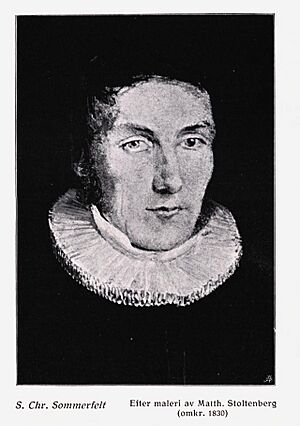Søren Christian Sommerfelt facts for kids
Søren Christian Sommerfelt (born April 9, 1794 – died December 29, 1838) was a Norwegian priest and a scientist who studied plants. He is most famous for his work on cryptogams, which are plants that reproduce using spores, like mosses and ferns.
Søren was born in Toten, Norway. His father, Christian Sommerfelt, was a county governor. When Søren was 15, in 1811, he started studying at the University of Copenhagen. He first studied to become a priest, but he also loved science. In 1816, he moved to Oslo to finish his studies in theology.
In 1818, he became a priest in Saltdal in Nordland. He worked there until 1824. After that, he became an assistant priest in Asker and later a vicar in Ringebu.
Contents
Søren's Life and Plant Studies
Søren Christian Sommerfelt was born on a farm called Sukkestad. He loved plants from a young age. Even as a student, he was offered a job at the new university in Kristiania (now Oslo). But things changed, and he became a priest instead.
Even though he was a priest, he spent all his free time studying plants. In the early 1800s, many people thought he was one of Norway's best plant scientists. He was known for understanding all kinds of plants, both big and small.
Discoveries in Saltdal
On May 28, 1818, Søren married Jørgine Maria Krohn. Soon after, he started his job as a priest in Saltdal. There, he found many unusual plants. He wrote down many observations, which became a huge scientific book.
He also wrote about the culture and daily life of people in Saltdal. His writings are considered some of the best descriptions of a Norwegian village from that time. They help us understand how people lived back then.
Later Life and Health Challenges
Søren worked very hard studying plants in Saltdal. But he was also a good priest. The local Bishop, Mathias Bonsach Krogh, helped him move forward in his church career.
In 1824, he became a chaplain in Asker. Then, in 1827, he became the main priest in Ringebu. That same year, he traveled to Western Norway and got sick with typhoid fever. This made him have poor health and bad eyesight for the rest of his life.
Even with his illness, he kept studying plants. He died when he was only 44 years old. Two years before he passed away, he even brought together important plant scientists from Scandinavia in Ringebu.
Søren's Family
Søren and Jørgine had ten children together, five girls and five boys. When Søren died, his wife was expecting their tenth child. She had to raise the children by herself without much money.
However, many of their children still got a good education. One son, Christian Sommerfelt, became a priest, a mayor, and a member of the Norwegian Parliament. Another son, Karl Linne Sommerfelt, became a principal at a school.
Søren's Contributions to Botany
Søren Christian Sommerfelt was the first person in Norway to be called a mycologist, which is a scientist who studies fungi. He discovered several new types of plants, especially cryptogams.
Some plants and insects are named after him, like the ant Aphaenogaster sommerfeldti and the lichen Pertusaria sommerfeltii.
His important books include:
- Florae lapponicae (1826) – This book is about plants found in the northern parts of Europe.
- Physisk-oeconomisk Beskrivelse over Saltdalen i Nordlandene (1827) – This book describes the nature and economy of Saltdal.


